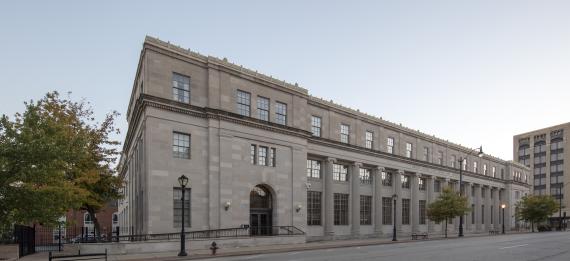Location: 600 E Monroe St, Springfield, IL 62701
Springfield was founded in 1818. It is the county seat of Sangamon County and became the capital of the state of Illinois in 1837.
The economic base of Springfield is diverse, supported by state government, agriculture, business, industry and tourism. The U.S. Postal Service arrived in Springfield in 1823. Its location changed continuously. In 1856, the U.S. Congress appropriated $50,000 for a new building for the U.S. Post Office, but the project was put on hold due to the Civil War. In 1863, the appropriation was resurrected, and a federal building housing the U.S. Post Office was begun in 1867. The building was completed in 1869 at Sixth and Monroe Streets, part of the site of the present building. Major additions were constructed but were insufficient. In 1928, an appropriation of $200,000 for the demolition of the existing building and $450,000 for the construction of a new building had been approved. Construction on this building began in 1929 and was completed in late 1930. Construction costs totaled $711,272. The Federal Building was built to house all federal offices, the U.S. Post Office, and the U.S. Courthouse.
The Paul Findley Federal Building was designed by James A. Wetmore, Acting Supervising Architect of the U.S. Treasury Department; construction drawings were completed in November 1928. The general contractor was Murch Brothers of St. Louis, Missouri, and the cornerstone was placed October 17, 1929. In the original design, the post office occupied the entire first floor. The public corridor extended along the north wall, a large mail workroom with two large skylights was in the center portion, and secondary lobbies at the east and west sides provided access to offices. Mechanical and electrical equipment, lounges, and public restrooms were located in the basement. The second floor provided offices for the tax department and prohibition administration. The U.S. Weather Bureau, the Federal District Courtroom, judges’ chambers, Federal Marshal’s office and jury accommodations were located on the third floor.
The Paul Findley Federal Building is of historical and architectural significance. The building represents an important time in the history of Springfield. The construction drawings were completed in the year before the stock market crash in 1929. The building was completed after the beginning of the Great Depression, and before the construction projects of the New Deal. Therefore, the Paul Findley Federal Building is one of few buildings in Springfield constructed during the 1930s.
The Paul Findley Federal Building is a good example of the federal architecture of this time in Springfield. The design is a combination of the Federalist (or Neoclassical) style (common for post office buildings during the first thirty years of the century), and the Art Deco style (popular for post office buildings in the later 1930’s). Examples of the Federalist details include the symmetry of the elevations, cornices, columns, and the terra cotta parapet. However, the design of the columns, pilasters and cornices are more streamlined than typical Federalist post office designs of this era. The simple entrance openings and the lack of window surrounds and grand entrance stairs are signs of the Art Deco influence.
This building is also significant because of the integrity of exterior. The exterior remains primarily intact, carefully maintained and has had few alterations. In 1983, the building was renamed to honor Illinois congressman Paul Findley.
Facts
- Architects: James A. Wetmore
- Construction Dates: 1929-1930
- GSA Building Number: IL0173ZZ
- Landmark Status: Listed in the National Register of Historic Places

 U.S. General Services Administration
U.S. General Services Administration
